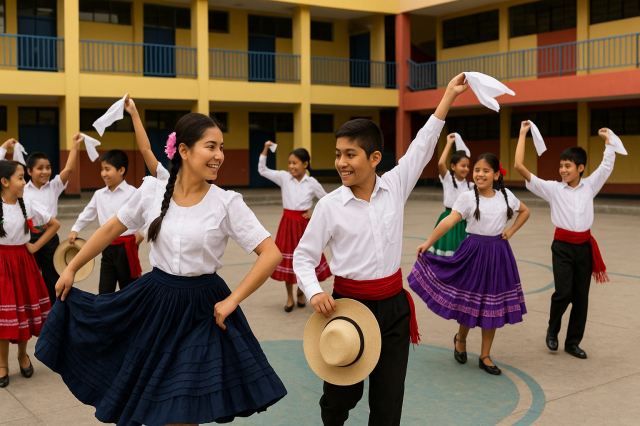Traditional Peruvian dances are one of the richest ways to express the country's cultural diversity. Incorporating them into school activities not only promotes art and physical expression but also strengthens national identity from an early age.
In this article you will learn how to integrate Peruvian dances into the classroom and school celebrations, with practical and meaningful ideas for students and teachers.
The importance of teaching traditional dances in school
In Peru, traditional dances are much more than a folkloric spectacle: they represent the history, beliefs, and customs of each region. Including them in the educational sphere helps students understand the value of diversity and respect for cultural roots.
In addition, the practice of dances:
It promotes teamwork and discipline.
It improves coordination and self-esteem.
It stimulates memory and creativity.
Promotes respect for local and national customs.
👉 You can complement this topic with our article on school projects about Peruvian traditions , ideal for teachers looking to integrate culture and learning.
How to integrate traditional dances into the classroom
1. Link dances with school commemorations
An effective way to include dances is to associate them with important dates on the school calendar.
For example:
National Holidays (July): Marinera, huaylas or festejo.
Farmer's Day (June 24): Andean dances such as the huayno or the Ayacucho carnival.
Early Childhood Education Week (May): Short choreographies of Amazonian dances adapted for children.
School Anniversary: Representative choreographies from different regions of the country.
Each celebration thus becomes an opportunity to revive customs and learn about Peru in a fun and participatory way.
2. Create dance workshops as part of the curriculum
Extracurricular or artistic workshops may include modules on traditional dances. These workshops can be quarterly and focus on a specific region.
Coast: Celebration, zamacueca, tondero.
Sierra: Huayno, Cajamarca carnival, scissors.
Jungle: Gang, anaconda, sitaracuy.
In addition, students can research the history, clothing, and music of each dance, integrating areas such as history, art, and communication .
📚 This interdisciplinary approach can also be part of educational projects, as explained in school activities linked to commemorative dates .
3. Promote school competitions and festivals
Traditional dance festivals are a highly valued tradition in Peruvian schools, especially during the national holidays.
To organize them successfully, it is recommended to:
Form student and teacher committees for coordination.
Promote the inclusion of dances from all regions of Peru.
Value the effort and cultural research, not just the choreography.
Include narrated presentations that explain the origin of each dance.
💡 An innovative touch is to include a “virtual festival” , broadcast on the school's networks, so that families can participate from home.
4. Make costumes and recycled materials
Involving students in creating costumes and decorations is a form of art and environmental education .
Skirts, crowns, or decorative items can be made from recycled materials. This reinforces values such as sustainability and teamwork.
5. Linking dance with history and tourism
Each traditional dance has a history linked to a town or region. Students can research the following:
The geographical origin of dance.
The patron saint festivals where it is performed.
Its tourist or cultural importance.
For example:
The marinera dance in Trujillo is an Intangible Cultural Heritage and has its own international festival.
The Cajamarca carnival is one of the most joyful celebrations in the country.
The scissor dance represents the Andean worldview and is recognized by UNESCO.
These topics can be linked to other blog articles such as regional festivals in Peru or sustainable cultural tourism .
Educational benefits of integrating dance into the classroom
| Educational aspect | Main benefit |
|---|---|
| Emotional development | It strengthens self-esteem and artistic expression. |
| Social inclusion | Encourage the participation of all students |
| Active learning | It promotes research and creativity |
| National identity | It strengthens the love for Peruvian traditions |
Example of a school project with traditional dances
Title: “Peru dances in my school”
Duration: 3 weeks
Objective: To strengthen cultural identity through the practice of typical Peruvian dances.
Activities:
Research on dances by region.
Creation of informative murals.
Rehearsal and presentation of dances.
Cultural fair with costume exhibition and music.
This type of project integrates art, history, values, and teamwork, strengthening intercultural education.
Promoting cultural identity from the classroom
Traditional dances should not be seen as a mere recreational activity, but as a pedagogical resource that connects the past with the present.
Every movement, outfit, or melody tells a story of resistance, cultural mixing, and pride.
Incorporating them into the educational environment is a way to preserve Peru's cultural heritage and transmit the value of diversity to new generations.
